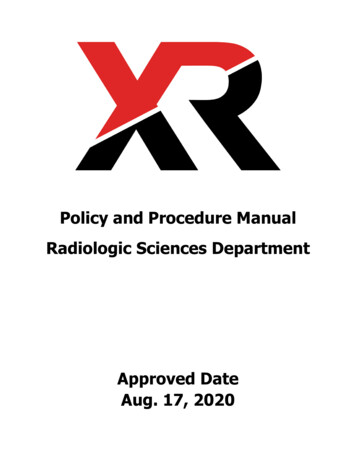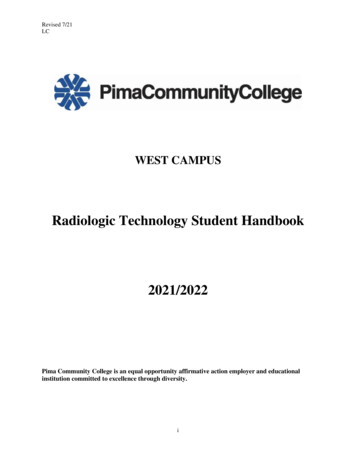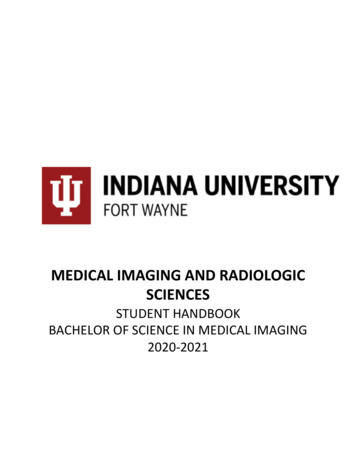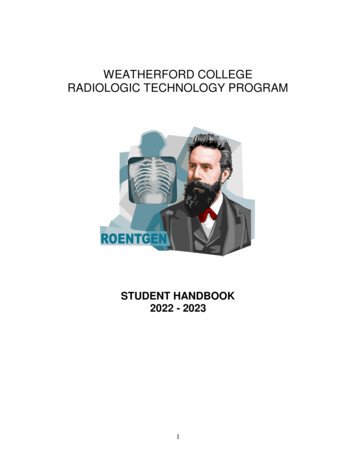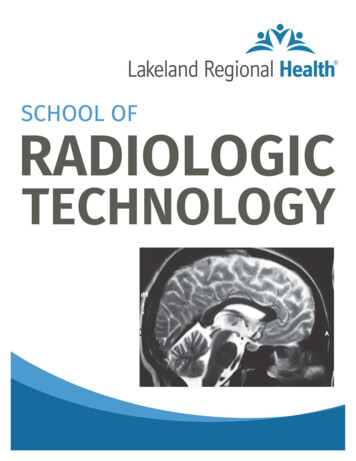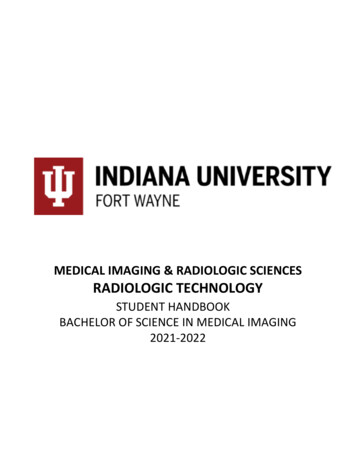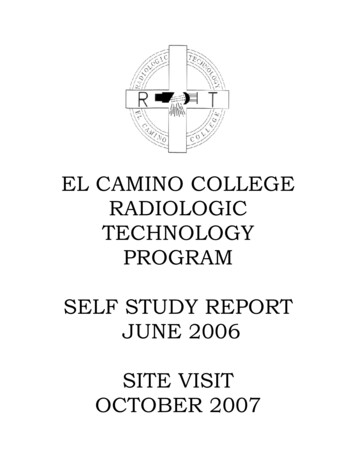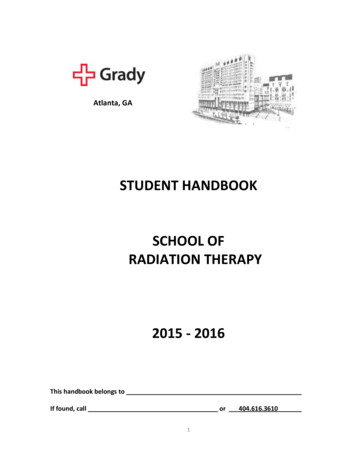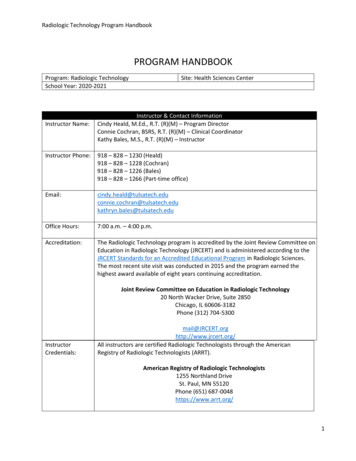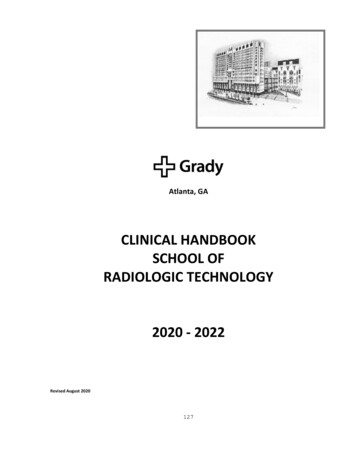
Transcription
Atlanta, GACLINICAL HANDBOOKSCHOOL OFRADIOLOGIC TECHNOLOGY2020 ‐ 2022Revised August 2020127
INTRODUCTION TO CLINIAL EDUCATIONThe Grady Health System Program in Radiologic Technology is committed to quality health care, qualityeducation, professional standards of accreditation and credibility in the health profession. The major goalof the program in radiologic technology is to enable the student to develop skills that will allow them toperform the duties of a radiologic technologist successfully. The first step in this process is the acquisitionof knowledge through classroom and clinical learning experiences. It is then necessary to practice theseskills until they are mastered.Simultaneous with classroom instruction, the first six weeks of orientation will prepare the student forthe clinical setting. In the first portion of clinical, students will observe staff radiographers in the clinicalarea, learning basic patient care handling skills. Participation in the clinical area becomes increasinglymore active, with the student assisting the staff radiographers with radiographic procedures, then,actually performing the procedure with the staff radiographer observing. Finally, when the studentbecomes competent in an area, the student will actually perform the procedure with only remotesupervision. A qualified radiographer must be present during student performance of a repeat of anyunsatisfactory radiograph.Enclosed are the components of the clinical evaluation system, which include: policies concerningattendance, uniform attire, clinical reprimand procedures, and a step‐by‐step description of the areas ofclinical rotation, clinical grading system, clinical objectives, sequence of laboratory evaluations, andlaboratory objectives.CLINICAL ROTATIONSThe student is placed on a weekly rotation schedule. During the first year, the student is rotated throughroutine radiographic areas. These rotations will include, but are not limited to: fluoroscopy, mobileradiography, orthopedics, pediatrics, OR, day/evening emergency, 5 Grady Neighborhood clinics and 3additional off campus hospitals or clinics. During the second year students are given the opportunity tobe scheduled in specialized areas such as: Special Procedures, mammography, CT, MRI, Ultrasound,Nuclear Medicine, Cardiac Cath, Radiation Oncology, PET, GA Cancer Center, CT, and diagnostic, etc.Each student in the Program in Radiologic Technology will spend the percentage of time in the clinicalrotations listed below. **This is subject to change based on the COVID pandemic128
CLINICAL AREAS AND HOURSDAY SHIFTORTHOEMEREMER 2ORFLUOROPORTCHESTIDPASA YANCEYKirkwoodBrookhavenEastpointCamp CreekPIEDMONT WestCHOA HSPeachtree Orthopedic ClinicsKaiser PermanentePercent of clinical timeAFTER HOURS DIAGNOSTICAREAS1 weekOrthopedics at Grady Health SystemEmergency Radiology at Grady Health SystemEmergency Radiology at Grady Health System – hours; 3pm‐7pm M‐FOperating Room at Grady Health SystemFluoroscopy at Grady Health SystemPortable Radiography at Grady Health SystemChest Radiography at Grady Health SystemPonce De Leon Center – diagnostic radiology (Satellite Grady Clinic)Asa Yancey Health Center – diagnostic radiology (Satellite GradyClinic)Kirkwood Health Center ‐ diagnostic radiology (Satellite Grady Clinic)Brookhaven Health Center ‐ diagnostic radiology (Satellite GradyClinic)East Point Health Center ‐ diagnostic radiology (Satellite GradyClinic)Camp Creek Comprehensive Health – pending JRCERT approvalPiedmont West Outpatient Center ‐ diagnostic radiographyChildren’s Healthcare of Atlanta at Hughes Spalding Day Clinical4 locations; POC Main, POC College Park, POC Northside, POC WestPaces2 locations; Kaiser Permanente SouthWood and Townpark88% of clinicalPercent of clinical timeChildren’s Healthcare of Atlanta at Hughes Spalding Evening Clinical–4pm‐9:30pm Monday – Thursday off on FridayWeekend Children’s Health Care of Atlanta at Hudson Bridge orSatellite Blvd – 9am‐7pm Saturday & SundayEmory University Hospital Midtown – Evening clinical6pm‐10pm Monday –Friday5% of clinicalSPECIALIZED IMAGING AREASNuclear Medicine & PET CTMammographyComputerized TomographyPercent of clinical timeTotal of 6 weeks; the student chooses from the following areas:InterventionalUltrasoundNeuro RadiographyMRIRadiation TherapyCardiac Cath Lab7% of clinical areas2 weeks1 weekClinical schedules are posted on the Clinical Education Portal and on the third floor sign‐in area,emergency area, Clinical instructors offices, and in the Program Office. Students are given a copy of theclinical schedule prior to the beginning of the semester. Clinical sites are sent a copy of clinical schedulesat the beginning of each semester.129
PROPER UNIFORM ATTIREUniformGreen scrub shirt* & green scrub pants* (Uniform cannot be too tight or tooloose.)Any shirt worn under uniform shirt must be solid white, solid gray, or solid black,no writing on that undershirt may be visible. Under shirt must be tucked in. Pantsmust come to ankle. Pants cannot touch the floor. Pants must be worn at thewaist (underwear must not be seen)ShoesSOLID Shoes; no open back, sides, or toes. Colors; Gray, White OR Black athleticor clinic shoes (including soles of shoe). Shoes must be all leather, or any materialthat does not allows fluid to penetrate.Solid white or solid black socks or stockings must be worn (no low cut socks)Socks/StockingsLab coatID badgeDosimetry badgeLead markersMask surgical/N‐95)and EyewearTattoosHats/Caps/Head coveringsAccessoriesUnderclothesGreen lab coat with school emblem*Identification badge must be worn at collar level with photo visible. (no buttons orpins allowed on ID badge unless approved by the Program).Worn at collar.Worn on the back of ID badge.COVID precautions – when entering the hospital the student must be wearing atleast a cloth mask. While in the clinical setting students are required to wear aprocedural ear loop mask. A cloth mask may we worn over the procedural ear loopmask. Students are also required to wear goggles or a face shield when providingpatient care.Rings & bracelets ‐ only one ring or bracelet may be worn on each hand. Necklace‐ must be worn under uniform. Earrings ‐ only one earring is allowed in each ear,they must be small (no larger than 1 inch in diameter). Other jewelry ‐ no jewelryis permitted in the tongue, lip, eyebrow or nose except for religious reasons.Hair may be worn as long as you like, but if it is longer than shoulder length, itMUST be tied back away from the face while working in the hospital in patient careareas. If a hairband or barrette are worn it must be solid black, white or gray colorin color only and ½ inch in width (no headbands). Hairstyles and color must beprofessional (colors not approved include ; purple, green, blue, yellow, bright red,or pink) and not of extreme design.Students must be clean shaven. Beards and mustaches may be grown if they arekept trimmed (no longer than ½ inch away from face) and sanitary. Facial hairmust not interfere with the seal on the isolation mask.Use makeup in moderation in a tone which denotes professionalism in a hospital.Fingernails may not extend more than 1/4 inch beyond the fingertip. No acrylic,gel, gel polish, SNS (nail powder) or tips on nails, no artificial nails. Students maywear the following color nail polish: clear, pearl, white. No jewels or designs in nailpolish are allowed.Dark glasses will not be worn indoors while on duty.Tattoos must be covered during clinical education.Hats, caps or head coverings are not allowed unless worn for religious reasons.Must be solid black in color only, no fringe.Fanny packs (black in color) are acceptable. No cell phone OR electronicdevices/watches turned on.Underwear should NOT be visible under the uniform.130
Electronic DevicesNO electronic devices (including cell phone, I‐pod, smart watch, digital watches,etc.) are allowed to be used during clinical hours. No electronic devices on duringclass hours except for use of the course material.*Green scrub shirt, pants, and lab coat must be purchased from the designated vendor.Uniforms should be CLEAN AND PRESSED and in good repair (not torn) at all times including classroom,shoes polished, socks/stockings in good shape. Uniforms should be properly fitted. Students must wearENTIRE uniform at all times. This dress code is an attempt to be clear, BUT THE EVALUATION AND/ORDEVIATION OF THE UNIFORM ATTIRE IS LEFT TO THE DISCRETION OF THE PROGRAM.Proper uniform attire is to be worn in ALL AREAS of clinical rotation. Students not attired in the properuniform will receive a Student Disciplinary form (this will affect the clinical grade). The student will besent home to change into the proper uniform. Time missed will be made up.RADIATION MONITORINGIn order to insure proper precautions against radiation accidents, all radiology personnel and students areprovided with dosimeters for radiation monitoring and control. The dosimeter is changed on the first dayof each month. Quarterly reports are available in the instructors’ offices, so that each person who worksin the area has a record of their accumulated radiation dosage. A yearly report is kept in the student'spermanent record. All radiography student dosimeters are to be hung on a designated badge board atthe end of each clinical rotation shift.PERSONAL HYGIENE1. Students are expected to take pride in their personal appearance and hygiene. First impressionsare critical when meeting patients and their families and may influence the professional rapportyou are able to establish with them. Equally important is how students are regarded by theirinstructors, clinical staff, and physicians who may be a future job reference, employer, orcolleague.2. Students must demonstrate acceptable personal hygiene. Daily bathing with soap, shampooinghair, shaving, brushing teeth, and wearing deodorant are required.3. Failure to comply with the appropriate personal hygiene policy may result in the student beingsent home. Time from clinical missed must be made up.4. No overwhelming or excessive perfume, scented body sprays, lotions, creams, aftershave, orscented hair spray may be worn. The patient’s sense of smell is often heightened and extremelysensitive to odors. They may be offended or sickened by perfume or scents.5. Students are not allowed to smoke while attending clinical education. The patient’s sense orsmell is often heightened and extremely sensitive to odors. They may be offended or sickened bythe residual odor of smoke on hair, skin, clothes, and breath.UNIFORM DEFICIENCY1.Students who are out of proper uniform attire will receive a verbal writtenwarning using the Student Disciplinary form on the first occurrence for failure to followthe proper uniform attire. These offenses include radiation monitoring, electronicdevices, & personal hygiene. This will affect the clinical grade.2.The second offence of incorrect uniform attire will warrant a written warning using theStudent Disciplinary form.3.The third offence will warrant a written reprimand using the Student Disciplinary form.4.On the fourth offence, further action by the Program (i.e. Suspension, probation,dismissal) using the Student Disciplinary form.131
UNETHICAL BEHAVIOR1.A “profession” is an occupation that has or utilizes a specific body of knowledge, specialliterature, and a code of ethics. Students are expected to demonstrate ethicalprofessional conduct. Codes of ethics and professional regulations for healthcareproviders serve several important purposes: They protect the integrity of the profession They enhance the delivery of patient care They provide opportunities for personal growth while enhancingcompetence as care givers. Unethical behavior is defined as a student exhibiting qualities and characteristicsthat are inconsistent with the American Society of Radiologic Technologists (ASRT)Practice Standards for Medical Imaging, the American Registry of Radiologic Technologists(ARRT) Code of Ethics for Medical Imaging, The ARRT Rules and Regulations, or thatviolate appropriate moral, ethical, social, and/or legal aspects. Unethical behavior will include, but is not limited to:a.Violating the patient’s rights, pect5.Nondiscrimination6.Informed consentb.Professional misconduct including:1.Inappropriate speech and/or tone of voice Unprofessional, negative, or disrespectful attitude3.Using or being under the influence of alcohol or drugs4.Dishonesty, lack of integrity, or irresponsibility5. Violating professional and certification organization policies6. Off duty misconduct7.Violating civil or criminal law, including;a.Negligenceb.Assault and/or batteryc.Defamation of characterd.Invasion of privacye.False imprisonmentf.MalpracticePenalties will be assessed according to the severity of offense. See rule & regulations.UNSAFE PRACTICE1.Unsafe practice is defined as a student performing a procedure in an unsafe manner, causing harmor possible harm to patient, clinical staff, Program’s faculty, themselves, or equipment.2.Unsafe practice will include, but is not limited to:a.Injuring the patient, clinical staff, Program’s faculty, themselves, or others.b.Damaging equipment, accessories, or physical facilities.c.Failure to protect the patient, clinical staff, Program’s faculty, themselves, or others fromaccidental or unnecessary radiation exposure.d.Failure to wear radiation monitoring devicee.Excessive permissible radiation doses.f.Failure to practice Universal Precautions or utilize safety devices when appropriate orrequired.132
g.3.4.5.6.7.Holding a patient during a radiographic exam or holding an image receptor during aradiographic examFor the first occurrence the student will receive a written reprimand using the Student Disciplinaryform.For the second occurrence the student will be suspended using the Student Disciplinary form.For the third occurrence the student will be placed on probation using the Student Disciplinaryform.If any other infractions occur the student will be dismissed using the Student Disciplinary form.Unsafe practices that require more severe action by the programa. Performing a repeat radiographic image without a Registered Radiographer in the radiographicroom. The student will be reprimanded with one day suspension.b. Being under the influence of narcotics, alcoholic beverages, or controlled substances. Thestudent will be dismissed from the Program.ARRT CODE OF ETHICS for Radiologic Technologists1.The radiologic technologist acts in a professional manner, responds to patient needs, andsupports colleagues and associates in providing quality patient care.2.The radiologic technologist acts to advance the principal objective of the profession to provideservices to humanity with full respect for the dignity of mankind.3.The radiologic technologist delivers patient care and service unrestricted by the concerns ofpersonal attributes or the nature of the disease or illness, and without discrimination on the basisof sex, race, creed, religion, or socio‐economic status.4.The radiologic technologist practices technology founded upon theoretical knowledge andconcepts, uses equipment and accessories consistent with the purposes for which they weredesigned, and employs procedures and techniques appropriately.5.The radiologic technologist assesses situations; exercises care, discretion, and judgment; assumesresponsibility for professional decisions; and acts in the best interest of the patient.6.The radiologic technologist acts as an agent through observation and communication to obtainpertinent information for the physician to aid in the diagnosis and treatment of the patient andrecognizes that interpretation and diagnosis are outside the scope of practice for the profession.7.The radiologic technologist uses equipment and accessories, employs techniques and procedures,performs services in accordance with an accepted standard of practice, and demonstratesexpertise in minimizing radiation exposure to the patient, self, and other members of thehealthcare team.8.The radiologic technologist practices ethical conduct appropriate to the profession and protectsthe patient’s right to quality radiologic technology care.9.The radiologic technologist respects confidences entrusted in the course of professional practice,respects the patient’s right to privacy, and reveals confidential information only as required bylaw or to protect the welfare of the individual or the community.10.The radiologic technologist continually strives to improve knowledge and skills by participating incontinuing education and professional activities, sharing knowledge with colleagues, andinvestigating new aspects of professional practice.Copyright 2016 by The American Registry of Radiologic Technologists . All rights reservedSUPERVISION OF STUDENTS1.Students must perform imaging procedures under the DIRECT SUPERVISION of a Radiographeruntil the student achieves competency. Direct Supervision includes; The Radiographer will reviewthe procedure to be performed, evaluate the condition of the patient, be present during the133
conduct of the procedure, and will review and approve the resulting IMAGES. All OR (operatingroom) procedures are always performed under DIRECT SUPERVISION.2.After the student achieves competency, procedures can be performed under the INDIRECTSUPERVISION of a Radiographer. Indirect Supervision includes; Radiographer is immediatelyavailable to assist students regardless of the level of student achievement. Immediately availableis interpreted as the presence of a radiographer adjacent to the room or location where aradiographic procedure is being performed.3.**A qualified radiographer is present during student performance of any repeat of anyunsatisfactory radiograph.4.Students are not allowed to hold patients or image receptors (IR) during any radiographic procedures.ATTENDANCE POLICIESDay ShiftGradyCHOA at Hughes SpaldingPiedmont West Outpatient Imaging CenterPeachtree OrthopedicsKaiser PermanenteNeighborhood ClinicsGrady Emer 2Evening ShiftED CHOA at Hughes SpaldingEUHMWeekend DutyCHOA Satellite Clinics1.2.3.4.CLINICAL HOURS8:00am‐4:00pm Monday‐Friday8:00am‐4:00pm Monday‐Friday8:00am‐4:00pm Monday‐Friday8:00am‐4:00pm Monday‐Friday8:00am‐4:00pm Monday‐Friday8:30am‐ 4:00pm Monday‐Friday3:00pm‐7:00pm Monday‐Friday4:00pm – 9:30pm Monday‐Thursday ( ½ hour supper)6:00pm‐10pm – Monday‐Friday9:00am‐7:00pm Saturday & Sunday ( ½ hour lunch &supper)Students will clock in and out using the clinical education portal. If a student forgets to clock in/out, or if the computer is unavailable he or she will complete a verification form (located on theclinical education portal) and submit it to Troy Maxwell within one week of the occurrence so thattheir clinical time can be documented.a.the student is only allowed 2 of these occurrences per semester, after this 1 point will bededucted from the clinical grade for any other occurrences in that semester.b.If the verification form is not received within one week of the occurrence, the student willnot be given credit for those clinical hours. The clinical time will be deducted from thestudent’s PTO or if the student has used all of their PTO the student will have to make upthe clinical hours.The student must be in their proper uniform attire when clocking in or out and must reportimmediately to their assigned clinical area.Students assigned to all shifts in the Emergency Radiology department, CHOA at Hughes SpaldingChildren’s Hospital, the Imaging Center, Cardiac Cath, IDC, Brookhaven, Kirkwood, East Point, AsaYancey, EUHM, Piedmont West Outpatient Imaging Center, Kaiser Permanente Southwood orTown Park, Peachtree Orthopaedics, and the Radiation Oncology will clock in and out using theclinical education portal in that department.Students will have a 30 minute lunch/supper break if in clinical longer than 5 hours. Whenstudents are in the clinical setting the staff technologist or supervisor will determine the134
5.lunch/supper times.Students are allowed one 15 minute break during their clinical rotation. This break time will be atthe discretion of the technologist to whom the student is assigned. Break time will depend uponpatient flow. Break times are not always guaranteed.INCLEMENT WEATHER POLICYIt is urgent that the Grady Health System maintain operations during inclement weather conditions. TheSchools of Radiation and Imaging Technologies are full‐time programs. In case of inclement weather,every effort should be made to attend training hours as soon as conditions permit. The EducationManager will make a decision concerning closure or late opening of the program. Students will be emailedwith the notification. The notification will also be sent to local TV/radio stations and the clinical educationportal for announcement. If the Education Manager closes or delays opening, the clinical time will nothave to be made up. Any other time missed will be deducted from PTO hours. If time missed exceeds thestudent’s PTO hours, those remaining clinical hours will be made up during semester break. Students musteither call or email if conditions prohibit them from attending class/clinical during a weather emergency.When classes must be cancelled because of the weather event, the school will maintain contact withstudents through phone/emails to let the students know what day(s) classes will be rescheduled orconducted via Zoom on‐line.JURY DUTY/COURT APPEARANCE/MILITARY RESERVESIf a student is summoned for jury duty, subpoenaed for a court appearance, or ordered to report formilitary reserve duty, he/she must notify and provide supporting documentation to an instructorimmediately upon receipt of the notice. When the student has completed their court or jury dutyappearance they are expected to immediately return to their assigned clinical area. Time missed for juryduty, court appearance, or military reserve duty will be deducted from PTO time, if time exceeds PTOhours, the remainder of the clinical time missed will be made up during semester break. This time missedwill not affect the clinical grade.BEREAVEMENT LEAVEBereavement leave is available for the following family members: spouse, domestic partner, son ordaughter, parent, sibling, grandparent, grandchild, mother or father‐in‐law, sister or brother‐in‐law,daughter‐or‐son‐in‐law, aunt, uncle, step‐child, step‐parent, step‐grandparent, or step‐grandchild. Astudent is required to contact the School if he/she will be absent as a result of the death of an immediatefamily member. You will be granted up to 3 days of bereavement time per loss of family member. Suchabsences are not made up. However, if additional time off to attend to family and estate matters isrequested, this time missed must be made up during semester break. If time off is requested for funeralsof persons other than immediate family members, the time will be treated as authorized leave time andwill be deducted from PTO time, if time exceeds PTO hours, the remainder of the clinical time missed willbe made up during semester break. This time missed will not affect the clinical grade.LEAVE OF ABSENCE POLICYA leave of absence (LOA) is a temporary interruption in a student’s program of study. Leaves of absence,including maternity leave, can be granted to the student in unusual or emergency situations. A LOA mustmeet specified conditions to be counted as a temporary interruption in the student’s education. If a LOAdoes not meet the specified conditions, the student is considered to have ceased attendance and will bewithdrawn from the school. In order for a LOA request to qualify for approval:1.The student must submit a written request to the Program Manager in advance for a LOA.It should include the reason for the request. If the LOA is for health reasons, medical135
2.3.4.5.6.7.8.documentation of the need for a LOA should accompany the written request.The school may grant a LOA to a student who did not provide the written request prior tothe LOA, due to unforeseen circumstances. The school must receive a verbal request fromthe student within 24 hours of the initial absence, followed by a written request within 7days.There must be a reasonable expectation that the student will return from the LOA.The LOA together with any additional absences must not exceed a total of 160 clinicalhours.For medical LOAs, the student must provide a physician’s statement of fitness to return toacademic class and/or clinical duty.If a LOA extends longer than six weeks, the student MUST RESIGN OR BE TERMINATEDfrom the program.No more than one leave of absence will be granted during the length of the program.A student in their second year may request a LOA from the program for illness, Militaryreason, etc. The student must return the following year at the beginning of the semesternot completed previously.HOLIDAYSThe following holidays are observed by the Programs in Radiation and Imaging Technologies. Studentsare off on all Holidays. Some holidays occur during semester breaks.Labor Day (one day)Thanksgiving (two days)Christmas eve and Christmas (2 days)New Year Day (one day)M.L. King Birthday (one day)Memorial Day (one day)July 4th (one day)ACADEMIC BREAKS1.Students are given one to four weeks off between semesters.2.No other time off is given, unless approved by the Program.3.Students will make up any time missed from clinical over their allotted PTO time.4.Students are given a memo at the end of the semester to let them know how muchclinical time they owe, the dates of makeup time, and the clinical area in which the time isto be made up. All policies concerning clinical procedures will be followed during makeup time. Students are evaluated by the Staff technologist during the makeup time.Students will complete makeup time verification form at the end of each day.THREE MONTH PROBATIONARY PERIODDuring the first three months of the Program the student is not allowed to take any time off with theexception of sick or Dr. appointments, or court occurrences.PERSONAL TIME OFF (PTO)1.Students are allowed 12 hours of PTO time each semester. This time will be used forsickness, tardiness, or time off. Any additional time missed from the program will bemade up during the semester break.2.In in the event that a student has time remaining at the end of the semester, that studentwill be off whatever the remainder of the time left in the PTO time bank.4.PTO time does not carry over to the next semester.3.Attendance will affect the overall clinical grade.SICKNESS1.If the student is sick, he/she must call the Clinical Instructors, ext. (404) 616‐3584 or (404)616‐3352 between 7:30 am ‐ 9:00 am for Day Duty and leave a message on Voice Mail. Call136
2.3.4.5.6.7.8.between 2:00 pm ‐ 4:00 pm for Evening Duty (and you must call the Evening DutySupervisor). If you are sick when assigned to any of the affiliates you must call within 2hours of the beginning of the clinical shift. The student must also call the ClinicalInstructors (ext. 404 616‐3584). If the student fails to call in by the designated time, thiswill be considered an Unauthorized Absence. Students may e‐mail Troy Maxwell attmaxwell@gmh.edu.Sick time over the allotted 12 hours PTO will be made up at the end of the semester.Sick time without a Dr. note of documentation will affect the Clinical grade. (One point issubtracted from the final clinical grade for each occurrence).The program may require medical verification for your illnesses. Medical verificationmust be turned in to the Clinical Instructors within 48 hours of returning to clinical duty.Sick time with medical verification will not affect the clinical grade.Absences of 20 or more hours in a semester are excessive. If a student misses more than20 hours, his/her clinical attendance record will be reviewed by the Program for furtheraction, i.e. probation, dismissal.If attendance does not improve during the probationary period imposed by the Program,the student will be subject to further action.Medical leave of up to 6 weeks (includes class and clinical) may be approved by theprogram. It requires medical verification of need and a request by the student to be off.If a student misses more than 160 clinical hours during his/her training they will bedismissed from the program. The Program will take into consideration a documentedconsecutive illness.AUTHORIZED LEAVE TIME1.Educational leave time off, such as seminars and/or conventions, with approval from theProgram and with verification of attendance, does not have to be made up. Those onProbation may not be considered for this type of time away from the Program. If astudent fails to show verification of attendance, this time is considered an unauthorizedabsence and 5 points will be subtracted from the final clinical grade.2.Jury Duty leave will be granted when students present verification of Jury Duty. Clinicaltime missed will be deducted from the PTO time, or the student can request to change hisrotational shift for the period of Jury Duty.3.Funeral leave for death in the immediate family does not have to be made up. (SeeBereavement Leave policy)4.Notification of military reserve leave must be presented in advance to the Program. Thetime taken off for this leave will be deducted from the PTO time; any remainder of timeowed must be made up at the end of the semester.5.For a Declared Pregnancy, Pregnancy Leave may be arranged with the Program. Thestudent must submit a memo to the Program Director to receive Pregnancy leave time off.Time missed will be deducted from the PTO, any remainder of time owed must be madeup at the end of the semester(s). (See Leave of Absence Policy)6.Time off for sickness in immediate family (spouse, children) will be deducted from thePTO time, any remainder of time owed must be made up at the end of the semester.7.Elective Surgery ‐ All elective surgery m
be scheduled in specialized areas such as: Special Procedures, mammography, CT, MRI, Ultrasound, Nuclear Medicine, Cardiac Cath, Radiation Oncology, PET, GA Cancer Center, CT, and diagnostic, etc. Each student in the Program in Radiologic Technology will spend the percentage of time in the clinical
